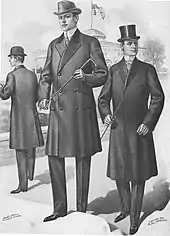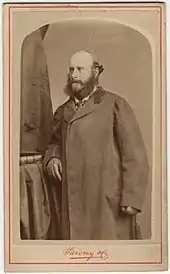Chesterfield coat
The Chesterfield is a formal dark knee-length overcoat with a velvet collar introduced around the 1840s in the United Kingdom, with prominence attributed to its namesake George Stanhope, 6th Earl of Chesterfield, then a leader of British fashion.[1][2]

The Chesterfield coat, with its heavy waist suppression using a waist seam, gradually replaced the over-frock coat during the second half of the 19th century as a choice for a formal overcoat, and survived as a coat of choice over the progression from frock coat everyday wear to the introduction of the lounge suit, but remained principally associated with formal morning dress and white tie.
A less formal derivation is the similar but lighter fabric, slightly shorter top coat called covert coat.
Characteristics

The dark Chesterfield, which comes with a defining velvet collar[2] has no horizontal seam or sidebodies, but can still be somewhat shaped using the side seams and darts. It can be single- or double-breasted, and has been popular in a wide variety of fabrics, typically heavier weight tweeds, or charcoal and navy, and even the camel hair classic, although such fabrics may be more associated with a more casual polo coat. These variations make it extremely versatile, so it can be worn with a city suit or even semi-formal dress, as well as casual sports jackets. It was a staple of smartly dressed men's wardrobes from the 1920s to 1960s, and has become a classic style for both men and even women.[2]
See also
References
- "A Man's Guide to Overcoats". artofmanliness.com. December 11, 2012. Retrieved 2013-11-03.
- Cumming, Valerie; Cunnington, C. W.; Cunnington, P. E. (2010-11-15). The Dictionary of Fashion History. Oxford; New York: Bloomsbury Academic. p. 46. ISBN 9781847885333.